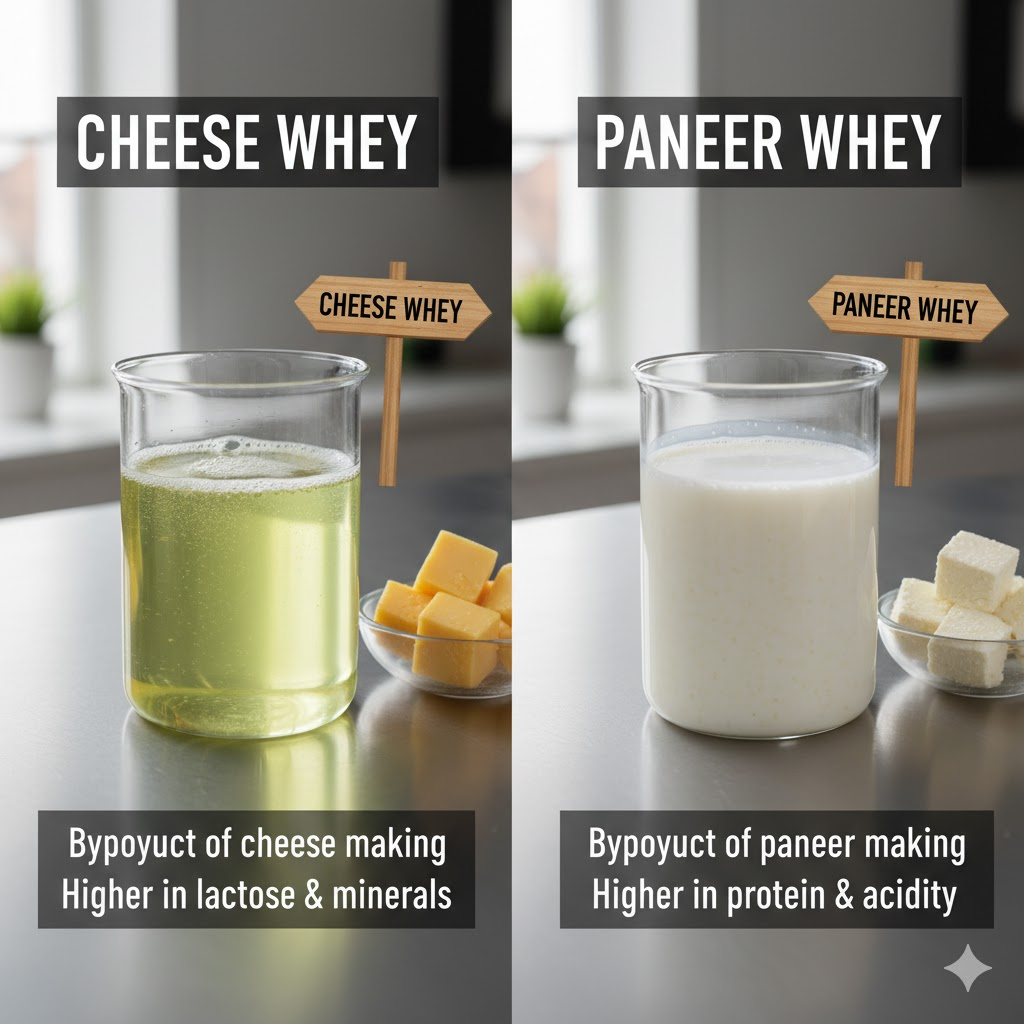Cheese whey and paneer whey are both liquid by-products obtained after coagulation of milk, but they differ primarily in the nature of the coagulant and the resulting composition.

1. Source of Whey
Cheese Whey:
Comes from cheese-making, where milk is coagulated using rennet (chymosin/rennin) and sometimes starter cultures.Coagulation is mainly enzymatic + acidic (due to lactic acid bacteria).
Paneer Whey:
Comes from paneer/chhanna manufacture, where milk is coagulated using acid (citric acid, lactic acid, or sour whey). Coagulation is acid-induced only, no rennet involved.
2. pH & Acidity
Cheese Whey: pH ~ 6.2–6.4, less acidic, depending on type (sweet whey or acid whey).
Paneer Whey: pH ~ 4.5–4.8, more acidic because direct acid is used.
3. Nutrient Profile
Cheese Whey:
Contains more whey proteins (β-lactoglobulin, α-lactalbumin, serum albumin, immunoglobulins).Retains soluble vitamins and minerals, but casein is mostly removed.
Paneer Whey:
Has lower whey protein recovery, because at low pH (≤5.2), many whey proteins denature and may get entrapped in the coagulum.Higher mineral content (calcium, phosphorus), since acid solubilizes casein-bound minerals into the whey.
Read More: Get more News from Dairy Sector
4. Functional Properties
Cheese Whey:
Excellent functional protein properties (gelling, foaming, emulsification) → widely used for whey protein concentrate (WPC), whey protein isolate (WPI), whey beverages, infant formula, sports nutrition.
Paneer Whey:
Less suitable for high-value whey protein recovery due to denatured proteins. Better for beverages (flavored whey drinks), bakery fermentation, animal feed, probiotic drinks, lactic acid production.
5. Industrial Relevance
Cheese Whey:
A global billion-dollar industry (WPC/WPI, nutraceuticals, functional foods).High export value (US, EU are leaders).
Paneer Whey:
Mostly produced in India, since paneer is largely an Indian product. Considered “acid whey,” handling is trickier. Utilization is more local (fermented drinks, cattle feed, biogas, bakery).
6. Environmental Concerns
Both are high BOD/COD streams, but:
Cheese whey: major waste management problem worldwide, but recovery tech is well-developed.
Paneer whey: less explored but equally polluting → needs better utilization strategies in India.
Composition of Whey
| Parameter | Cheese Whey (Sweet Whey) | Paneer Whey (Acid Whey) |
|---|---|---|
| pH | 6.2–6.4 | 4.5–4.8 |
| Total Solids (%) | 6.0–6.5 | 6.0–6.2 |
| Lactose (%) | 4.8–5.0 | 4.2–4.6 |
| Protein (%) | 0.6–0.8 (mostly β-lactoglobulin, α-lactalbumin) | 0.4–0.6 (denatured proteins + soluble casein fragments) |
| Fat (%) | 0.05–0.1 | <0.01 |
| Ash (%) | 0.5–0.7 | 0.7–0.9 |
| Acidity | Low (0.12–0.16% LA) | High (0.35–0.50% LA) |
Join Our “Dairy & Food Jobs Updates” WhatsApp group
Stay informed on all the latest news updates
All Agriculture Books Free Download
All Dairy Technology Books Free Download
All Agricultural Engineering Books Free download
All Horticulture Books Free Download
All Fisheries Science Books Free Download
For Daily Update follow us at:
Facebook Telegram Whatsapp Instagram YouTube
The contents are provided free for noncommercial purpose such as teaching, training, research, extension and self learning.
If you are facing any Problem than fill form Contact Us
If you want share any article related Agriculture with us than send at info@agrimoon.com with your contact detail.


